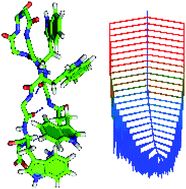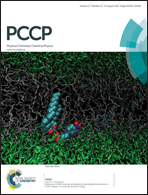Energy landscapes of a hairpin peptide including NMR chemical shift restraints
Abstract
Methods recently introduced to improve the efficiency of protein structure prediction simulations by adding a restraint potential to a molecular mechanics force field introduce additional input parameters that can affect the performance. Here we investigate the changes in the energy landscape as the relative weight of the two contributions, force field and restraint potential, is systematically altered, for restraint functions constructed from calculated nuclear magnetic resonance chemical shifts. Benchmarking calculations were performed on a 12-residue peptide, tryptophan zipper 1, which features both secondary structure (a β-hairpin) and specific packing of tryptophan sidechains. Basin-hopping global optimization was performed to assess the efficiency with which lowest-energy structures are located, and the discrete path sampling approach was employed to survey the energy landscapes between unfolded and folded structures. We find that inclusion of the chemical shift restraints improves the efficiency of structure prediction because the energy landscape becomes more funnelled and the proportion of local minima classified as native increases. However, the funnelling nature of the landscape is reduced as the relative contribution of the chemical shift restraint potential is increased past an optimal value.


 Please wait while we load your content...
Please wait while we load your content...